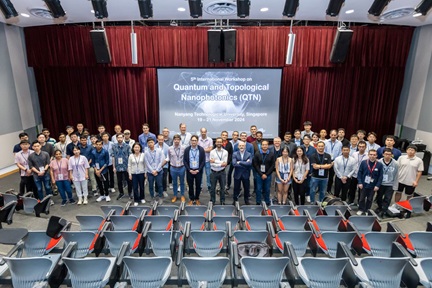IAS Lee Kong Chian Distinguished Professor Public Lecture by Prof Duncan Haldane
Entanglement, Topological Quantum Matter and the Second Quantum Revolution

[From left:] Nanyang Asst Prof Yang Bo (SPMS), Assoc Prof Elbert Chia (SPMS), Prof Liew Wen Siang (Assoc Chair, Research, SPMS), Prof Juan-Pablo Ortega (Assoc Chair, Faculty, SPMS), Prof Phan Anh Tuan (Chair, SPMS), Nobel Laureate Prof Duncan Haldane, Prof Sum Tze Chien (Director, IAS) and Prof Guan Yong Lian (Assoc Vice President, Infrastructure & Programmes, NTU President's Office).
Prof Duncan Haldane, Sherman Fairchild University Professor of Physics from Princeton University, most notably the Nobel Prize winner in Physics in 2016 for “the theoretical discoveries of topological phase transitions and topological phases of matter” was the esteemed speaker for the public lecture held on 5 January 2023 at the Tan Chin Tuan lecture theatre. Prof Sum Tze Chein, Director IAS, gave the welcome address followed by the opening remarks given by Prof Phan Anh Tuan, Chair SPMS.
Prof Haldane addressed the lecture theatre packed with audiences and captivated their attention as he took them on a colourful scientific journey entitled “Entanglement, Topological Quantum Matter and the Second Quantum Revolution”. He highlighted the development of the understanding regarding quantum mechanics over the years and how it is useful in the development of intriguing materials and advanced technologies.

Traveling through time and citing a lineage of giants, Prof Haldane talked about the early works in quantum mechanics by Weinberg, Dirac, Faraday and later by Richard Feynman with discussions on the atomic scale machines and computers in 1959.
Prof Haldane also gave his thought on the origin of EPR (Einstein, Podolsky and Rosen) pair, followed by discussion on the recent years of advances in the area, which has realised that quantum condensed matter can exhibit unexpected properties associated with long range quantum entanglement. He presented how entanglement has proven to be fuel for quantum information processing. He quoted “the key idea of entanglement which serves as the bold property of quantum mechanics which draws as the hope for a topologically protected quantum computer”.
In his passionate and precise talking about the fundamentals of quantum mechanics, Prof Haldane said that history tell us that basic research and technology are two sides of the same coin - without basic research, novel technologies cannot be invented. Through time, scientists have made discoveries with no immediate applications, but serendipitously or through combinations of breakthroughs, after a long maturation time, these discoveries have led to innumerable inventions that have revolutionised our daily lives, for example, personal computers, lasers, MRI scanners, or the GPS software guiding us to our exact destinations. Prof Haldane said that this is the time for a “second quantum revolution” and it will be helpful in further deepening our understanding of quantum mechanics and development of new technologies in the future. He said that it is a realistic dream for him to see the development of topologically protected Qubit.
As a parting thought, Prof Duncan Haldane concluded his lecture by enlightening the audience with The Moral that need three communities to collaborate with one another: the Toy-Model Builders - to find what kind of unexpected physics can in principle occur, deep mathematical understanding of what principles explain the unexpected toy-model physics, and the cutting-edge materials science to bring the theory to reality.

In his motivational message to the student audience, he quoted:
“Any of you potentially could end up being a great scientist, you don't need to be a special "genius" like Einstein. You need LUCK to stumble across something truly unexpected, that turns out later to have impact. The key is to be prepared, and the ability to recognise what you found as something remarkable. We also need the commitment to follow it through and fight for it”.
Abhishek Singh | PhD student, School of Physical and Mathematical Sciences, NTU














/enri-thumbnails/careeropportunities1f0caf1c-a12d-479c-be7c-3c04e085c617.tmb-mega-menu.jpg?Culture=en&sfvrsn=d7261e3b_1)

/cradle-thumbnails/research-capabilities1516d0ba63aa44f0b4ee77a8c05263b2.tmb-mega-menu.jpg?Culture=en&sfvrsn=1bc94f8_1)






